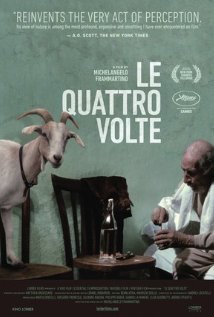Le Quattro Volte
Pythagoras had a theory called metempsychosis, which meant transmigration of the soul, or the reincarnation from one form to another. Michelangelo Frammartino has expressed this theory in his deceptive film Le Quattro Volte (The Four Times), which follows a soul from man to animal to vegetable to mineral.
You won't learn about Pythagoras watching the film--I read about that later, but I did pick up on subtle hints of it. The film has four sections, as one might expect. The first centers on an old goatherd. He dies, and just after his casket is walled up in a mausoleum, the action cuts to the birth of a goat. It doesn't take a Greek philosopher to presume that Frammartino is suggesting the old man has passed on to the baby goat.
The next section is almost a nature documentary, which could be called Goats! The baby goat gets left behind his flock, and wanders the forest, eventually settling into a sleep beneath a tree. The next thing we know, the tree is being cut down, so I guess the little kid didn't make it.
The tree is used in a ceremony of some sort, where it is stripped but all of its top branches, then adorned, and then allowed to drop, where everyone grabs at the trinkets. Finally, the fourth section has the tree cut apart, it's kindling put into a kiln, where it is turned to charcoal.
This is not a film for anyone with ADHD. It is very slow moving, and there is no dialogue. There are some mesmerizing scenes, such as a long, single take of an Easter procession, followed by one man trying to join the parade, but being stopped by a barking dog. This leads to a truck careening into the goat pen, but the camera turns away at that point, following the man and the dog, and the crash happening off screen.
Occasionally my mind wandered a bit during Le Quattro Volte, but most of it was interesting. It was filmed in Calabria, Italy, where Pythagoras had a sect. The film does not mention the Pythagorean theorem, which if I remember correctly, is a squared plus b squared equals c squared.
You won't learn about Pythagoras watching the film--I read about that later, but I did pick up on subtle hints of it. The film has four sections, as one might expect. The first centers on an old goatherd. He dies, and just after his casket is walled up in a mausoleum, the action cuts to the birth of a goat. It doesn't take a Greek philosopher to presume that Frammartino is suggesting the old man has passed on to the baby goat.
The next section is almost a nature documentary, which could be called Goats! The baby goat gets left behind his flock, and wanders the forest, eventually settling into a sleep beneath a tree. The next thing we know, the tree is being cut down, so I guess the little kid didn't make it.
The tree is used in a ceremony of some sort, where it is stripped but all of its top branches, then adorned, and then allowed to drop, where everyone grabs at the trinkets. Finally, the fourth section has the tree cut apart, it's kindling put into a kiln, where it is turned to charcoal.
This is not a film for anyone with ADHD. It is very slow moving, and there is no dialogue. There are some mesmerizing scenes, such as a long, single take of an Easter procession, followed by one man trying to join the parade, but being stopped by a barking dog. This leads to a truck careening into the goat pen, but the camera turns away at that point, following the man and the dog, and the crash happening off screen.
Occasionally my mind wandered a bit during Le Quattro Volte, but most of it was interesting. It was filmed in Calabria, Italy, where Pythagoras had a sect. The film does not mention the Pythagorean theorem, which if I remember correctly, is a squared plus b squared equals c squared.



Comments
Post a Comment